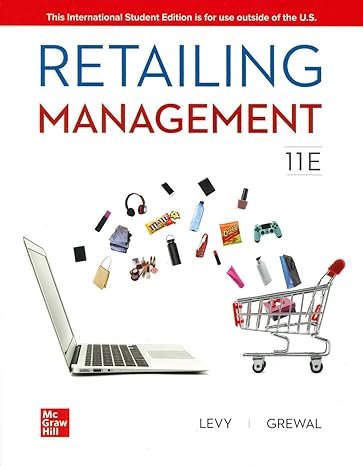
Comprehensive Review of “ISE Retailing Management”
Title: ISE Retailing Management
Authors: Michael Levy, Barton Weitz, and Dhruv Grewal
Edition: 10th Edition
Publisher: McGraw-Hill Education
Publication Date: February 3, 2018
Pages: 688
Overview:
“ISE Retailing Management” by Michael Levy, Barton Weitz, and Dhruv Grewal is a seminal textbook in the field of retail management, providing a thorough exploration of retailing principles, practices, and strategies.
The 10th edition of this book continues to offer an in-depth analysis of the dynamic retail landscape, integrating the latest trends and technological advancements.
Content and Structure:
Part I: Introduction to the World of Retailing
The book begins with a comprehensive introduction to retailing, setting the stage for the subsequent chapters.
It covers the fundamental concepts of retailing, the various types of retailers, and the multi-channel retailing environment.
This section is crucial for understanding the basics and the scope of retail management.
Part II: Understanding the Retail Consumer
This section delves into consumer behavior and the factors influencing purchase decisions.
It emphasizes the importance of understanding customer needs and preferences, which is critical for developing effective retail strategies.
The authors provide insights into consumer psychology, decision-making processes, and the impact of social and cultural factors.
Part III: Retailing Strategy
A significant portion of the book is dedicated to retail strategy, discussing how retailers can develop and implement effective strategies to achieve competitive advantage.
This includes strategic planning, market analysis, positioning, and the development of a retail mix.
The authors highlight the importance of aligning the retail strategy with the overall business strategy.
Part IV: Merchandise Management
Merchandise management is a core aspect of retailing, and this section covers it extensively.
Topics include merchandise planning, sourcing, buying, and inventory management.
The authors provide practical insights into assortment planning, vendor relations, and category management, emphasizing the role of data and analytics in merchandise decision-making.
Part V: Store Management
The book discusses store operations and management, including store layout, design, and visual merchandising.
It also covers store staffing, training, and performance management.
The authors emphasize the importance of creating an engaging in-store experience to attract and retain customers.
Part VI: Managing the Supply Chain
Supply chain management is critical to retail success, and this section covers the intricacies of supply chain operations.
Topics include logistics, distribution, and the integration of supply chain activities.
The authors discuss the impact of technology on supply chain efficiency and the importance of collaboration with suppliers and partners.
Part VII: Retail Communication Mix
Effective communication is key to retail success, and this section covers the various elements of the retail communication mix.
It includes advertising, sales promotions, public relations, and digital marketing.
The authors provide insights into developing integrated marketing communications and leveraging social media and digital platforms.
Part VIII: Managing the Customer Experience
This final section focuses on customer experience management, discussing how retailers can create and deliver superior customer experiences.
It includes topics such as customer service, loyalty programs, and the use of technology to enhance the shopping experience.
The authors emphasize the importance of customer-centricity in retailing.
Strengths:
- Comprehensive Coverage: The book covers all aspects of retail management, making it a one-stop resource for students and professionals alike.
- Real-World Examples: The authors use numerous case studies and examples to illustrate concepts, making the material relatable and practical.
- Updated Content: The 10th edition includes the latest trends and developments in retailing, such as e-commerce, omnichannel retailing, and the impact of technology.
- Strategic Focus: The book emphasizes strategic thinking and decision-making, helping readers develop a strategic mindset.
- Practical Insights: The authors provide practical advice and tools that readers can apply in real-world retail scenarios.
Weaknesses:
- Complexity: Some sections may be challenging for readers without a background in retailing or business, as the book delves into complex concepts and strategies.
- Length: At 688 pages, the book is quite lengthy, which may be overwhelming for some readers.
Conclusion:
“ISE Retailing Management” is an invaluable resource for anyone looking to deepen their understanding of retail management.
Its comprehensive coverage, practical insights, and strategic focus make it a must-read for students, educators, and retail professionals.
While it may be complex and lengthy, the wealth of knowledge it offers more than compensates for these minor drawbacks.
The 10th edition’s inclusion of the latest retail trends ensures that it remains relevant in today’s rapidly evolving retail landscape.


